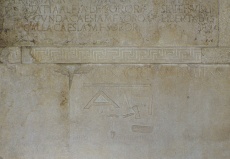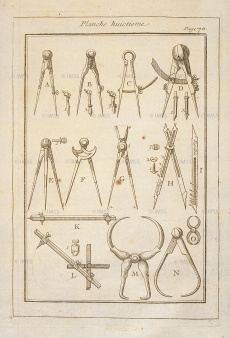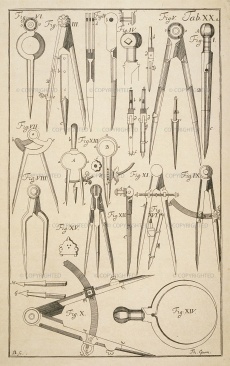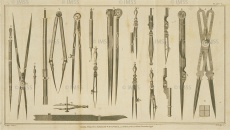Compasses
From Inventions
m (1 revision) |
|||
| Line 2: | Line 2: | ||
|nome= | |nome= | ||
| - | + | Since Renaissance times synonymous of seste (compasses), the name derives from the Latin "cum" and "passus", literally "with step", that is, at a measured or constant rhythm. | |
|inventore= | |inventore= | ||
| Line 8: | Line 8: | ||
|data= | |data= | ||
| - | |descrizione= | + | |descrizione= |
| + | Instrument for drawing circles, ellipses and other curved lines. Also instrument of measurement and for transferring measurements. The term "compass" or "compasses" denotes a wide range of instruments for drawing, measurement, and proportional calculation. Besides the more common compasses for drawing circumferences, widespread since antiquity, the Renaissance has left us a great number of special compasses, whose names reflect their specific functions: oval compasses to draw ellipses, hyperbolas and parabolas; two-point compasses—also called [[dividers]]—to divide lines and transfer measurements; [[Single-Handed Dividers | single-handed dividers]], to track routes on sea-charts; compasses with curved points, called [[Caliper Compasses | Caliper compasses]], to measure mouths of cannons, cannon balls, and columns; [[Three-Point Compasses | three-point compasses]] to reproduce maps; [[Four-Point Compasses | four-point compasses]], or reduction compasses, to enlarge or reduce drawings, divide lines and circumferences proportionally, and draw polygons; [[Eight-Point Compasses | eight-point compasses]] to measure fractions of degrees and carry out proportional calculations; [[Proportional Compasses | proportional compasses]] to perform arithmetic, geometric, and trigonometric calculations and to measure weights, gradients, and distances for military use; and sophisticated [[Surveying Compasses | surveying compasses]] that combined a magnetic compass, a windrose, and optical sights for surveying and for drawing topographic maps. | ||
|componenti= | |componenti= | ||
Revision as of 11:09, 12 November 2009
Since Renaissance times synonymous of seste (compasses), the name derives from the Latin "cum" and "passus", literally "with step", that is, at a measured or constant rhythm.
Description
Instrument for drawing circles, ellipses and other curved lines. Also instrument of measurement and for transferring measurements. The term "compass" or "compasses" denotes a wide range of instruments for drawing, measurement, and proportional calculation. Besides the more common compasses for drawing circumferences, widespread since antiquity, the Renaissance has left us a great number of special compasses, whose names reflect their specific functions: oval compasses to draw ellipses, hyperbolas and parabolas; two-point compasses—also called dividers—to divide lines and transfer measurements; single-handed dividers, to track routes on sea-charts; compasses with curved points, called Caliper compasses, to measure mouths of cannons, cannon balls, and columns; three-point compasses to reproduce maps; four-point compasses, or reduction compasses, to enlarge or reduce drawings, divide lines and circumferences proportionally, and draw polygons; eight-point compasses to measure fractions of degrees and carry out proportional calculations; proportional compasses to perform arithmetic, geometric, and trigonometric calculations and to measure weights, gradients, and distances for military use; and sophisticated surveying compasses that combined a magnetic compass, a windrose, and optical sights for surveying and for drawing topographic maps.
Bibliographical Resources
Scamozzi, Vincenzo. L’idea della architettura universale, Venezia 1615, Parte I, Lib. I, Cap. XV, p. 49: "…I compassi siano piuttosto d’ottone, che d’altra materia che s’irrugginisca; ben leggieri e sottili di gambe, purchè non tremino, all’uso di Francia…".
Images
Author of the entry: Filippo Camerota




